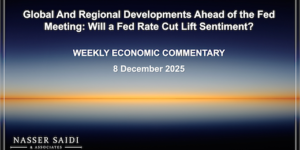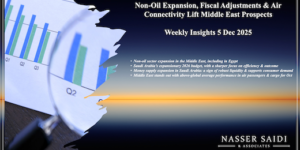Markets
At the start of last week, the US-China trade truce reached in Buenos Aires sparked optimism throughout global equities. By midweek investors realized that the optimism was hardly justified as Trump in a tweet described himself as Tariff Man. Then came the shocker, i.e. the arrest in Canada of Huawei CFO (and daughter of the founder) and the optimism collapsed together with the equities prices worldwide. The carnage spread from Wall Street (which suffered some of the deepest daily plunges of the year) to developed and emerging markets (but regional markets were among the least affected and held up well, except Egypt and Dubai). The VIX reverted to the level last seen in Feb. To exacerbate the sell off in risky asset came the fear that global economic growth might have peaked, as the non-farm payroll data in the US came below expectations and the US yield curve inverted for the first time in a decade. In currency markets the euro dollar rate was quite volatile, but within a range of 100 basis points, so after all it did not react much to the turmoil. The yuan recorded the best two-day gain since the revaluation in 2005 before the risk-off mood sunk in. The GBP was once again victim of the Brexit uncertainty after May was defeated in Parliament, (the cost to hedge against sterling volatility in short-run skyrocketed). The Brent oil price was heavily influenced by the expectations and news on the OPEC-Russia deal. On Thu it dropped more than 4% to below USD 59/barrel as Saudi Arabia said they were working on a deal to cut output that could fall short of market expectations. Then when cuts of 1.2 mbd were announced the price recovered somewhat to end the week little changed, despite another increase in US oil stocks by 3.577 mn barrels against expectations of a 0.769 mn rise. The gold price after weeks of quiescence vaulted to USD 1,250 per ounce thanks to the classic safe haven effect.
Global Developments
US/Americas:
- US non-farm payrolls increased by 155,000 in Nov, vs 237,000 in Oct and below market expectations of 200,000. Job gains occurred in health care, in manufacturing, and in transportation and warehousing. It is too early to say that the labour market is weakening, but surely financial markets were concerned.
- The US ISM Manufacturing PMI beat expectations leaping to 59.3 in Nov from 57.7 in Oct. New orders, production and employment were the main drivers.
- Unit labour costs in the US non-farm business sector increased by 0.9% qoq ann in Q3, reverting from a -2.8% drop in Q2. The figure results from a 3.1% qoq ann gain in hourly compensation and a 2.3% in labor productivity.
- New orders for US manufactured goods fell -2.1% mom in Oct following a 0.2% growth in Sep.
- The University of Michigan’s US consumer sentiment was almost steady at 97.5 in Dec, more or less near the average for 2018. Over the past 2 years, consumer sentiment has been above 90, a pattern not seen since 1997 to 2000.
- US initial claims for unemployment benefits rose by 10K to 234K. It was the third straight weekly increase to the highest level since May 19. Continuing claims increased to 1,710mn from 1,660.
- The seasonally adjusted IHS Markit Brazil PMI Composite Output Index rose to 51.6 in Nov from 50.5 in Oct thanks to stronger growth in both manufacturing (52.7 from 51.1 in October) and services (51.3 from 50.5) following Bolsonaro’s election.
Europe:
- The leaders of the Eurozone reached a deal on a reform package which includes some elements of a joint proposal set out in June by Macron and Merkel, including widening the remit of the EUR 500bn ESM to intervene in case of a bank collapse.
- The Eurozone’s retail sales advanced 0.3% mom (1.7% yoy) in Oct, partly offsetting a -0.5% (0.3% yoy) decline in Sep, thanks to food (0.6% mom vs -0.2% in Sep) and automotive fuel sales (1% mom vs 0.8% in Sep).
- Italy and the EU Commission are still at loggerheads over the 2019 budget and a compromise looks increasingly unlikely.
- UK PM May lost a crucial vote in Parliament, which underlined that a majority for the Brexit deal is hardly a done deal.
Asia Pacific:
- The Caixin China General Manufacturing PMI came in at 50.2 in Nov marginally higher than 50.1 in Oct. New orders accelerated, output was stable and export sales fell for the 8th straight month due to the trade war. Employment declined and inflationary pressures subsided.
- The Caixin China General Composite PMI increased to 51.9 in Nov from a 28-month low of 50.5 in Oct. the previous month. Total new work advanced at the strongest rate in 5 months, while input costs and output prices both dropped, indicating easing inflationary pressure.
- China’s inflation slowed to 4-month low of 2.2% yoy in Nov from 2.5% in Oct. Food inflation was at its lowest in 3 months and non-food prices rose the least in 7 months.
- China’s trade surplus shot up unexpectedly to USD 44.74bn in Nov from USD 38.43bn a year earlier. It was the largest trade surplus since Dec, as exports rose by 5.4% yoy and imports by 3.0%. The trade surplus with the US hit a fresh record at USD 35.55bn in Oct from USD 31.78bn in Sep.
- Japanese corporate investment on plant and equipment rose by 4.5% yoy in Q3, after surging 12.8% in Q2. Investment of manufacturing companies grew 5.1% vs 19.8% in Q2.
- The leading economic index in Japan increased to 100.5 pts in Oct from 99.6 pts in Sep.
- The Nikkei India Manufacturing PMI rose unexpectedly to an 11-month high of 54.0 in Nov from 53.1 in Oct. Sales and production advanced at the second-fastest rate in over 2 years and new export orders growth accelerated like never before in the past 4 years.
- The Nikkei South Korea Manufacturing PMI fell to 48.6 in Nov from 51.0 in Oct signaling a mild recession for the first time since Aug, as new orders declined at the fastest pace in 2 years due to a declining workloads, particularly in the automobile industry.
- South Korea’s current account surplus widened sharply to USD 9.19bn in Oct from USD 5.72bn a year earlier. Goods account surplus reached USD 11bn from USD 8.60bn a year ago.
- Australian GDP expanded by 2.8% yoy in Q3 vs 3.1% in Q2, the weakest pace in 2018.
Bottom line:It is increasingly clear that the US economy will slow over the next two years. The question is whether this will be just a marked slowdown or will end up in a recession (and for how long). The reform of the Eurozone’s governance will make it easier for countries that are solvent but fearful of a temporary loss of market financing to get “precautionary” credit lines from the ESM. Paradoxically while developed countries are facing some rough times, emerging markets that were until recently the main worry of international investors are stabilizing. Although the rise in inflation and interest rates is a concern, capital has returned to emerging countries since the summer of 2018, limiting the depreciation of their exchange rates. Export growth and lower oil prices have also provided a strong impulse.
Regional Developments
- The GCC Summit will be held today (Sun, Dec 9): the meeting of the GCC leaders (absent Qatar) will discuss issues including GCC integration and “cooperation in political, defense, economic and legal fields”.
- Bahrain appointed a new cabinet after parliamentary elections; the ministers remain the same as before except for a new finance minister.
- Egypt’s PMI stayed below the 50-mark for the third consecutive month, but strengthened to 49.2 in Nov (Oct: 48.6) thanks to modest declines in output. The employment index fell to its lowest level since Mar amidst easing inflationary pressures.
- Foreign reserves in Egypt increased to USD 44.513bn at end-Nov from USD 44.501bn in Oct.
- Egypt’s finance minister disclosed that the country is planning for at least two foreign currency bond issues in Q1 next year. Separately, the deputy finance minister stated that Egypt aims to lengthen the average maturity on its debt to 3.5 years by end-June from less than two years currently.
- According to the central bank, Egypt will auction USD 1bn worth of one-year dollar-denominated treasury bills on Mon(Dec 10).
- Jordan’s real estate trading volume fell by 14% yoy to JOD 4.815bn by end-Nov 2018. Iraqis were the top non-Jordanian investors (JOD 105.3mn or 42% of non-Jordanian transactions), followed by Saudis (16%) and Syrians (7%).
- Visitors to Jordan’s Petra increased by 49% yoy to 100,210 visitors in Nov, bringing the year-to-date total to 757,038 persons.
- The central bank of Kuwait has prepared a draft law regulating the bankruptcy and restructuring of local banks (independent of the general law prepared by the Ministry of Commerce and Industry). The law will allow the central bank to intervene early if there are indications of lack of soundness of the bank’s practices or exposure to financial risks.
- Kuwait’s ministry of education has frozen 1080 jobs occupied by expats for the fiscal year 2018-19; the ministry has the highest Kuwaitization rate across ministries and state-run institutions (at 95%).
- Lebanon’s government will start issuing local currency debt at market rates to encourage banks to buy the debt than just park money at the central bank. The Bank of Lebanon’s benchmark ten-year rate is 10.5%.
- Total outstanding credit extended by all depository corporations in Oman grew by 7.5% yoy to OMR 24.8bn by end of Sep. Credit to the private sector rose by 5.6% yoy to OMR 22bn during same period. Of the total credit to the private sector, the non-financial accounted for the highest share at 46.3%.
- Qatar announced an exit from OPEC after being part of it for 57 years, with an aim to refocus on “expanding its natural gas exports”. Of the 15 OPEC members Qatar ranks eleventh and makes up less than 2% of the cartel’s production.
- Qatar’s central bank sold QAR 700mn(USD 192.31mn) of treasury bills with maturities of three, six and nine months.
- PMI in Saudi Arabia grew at the fastest rate in 11 months, rising to 55.2 in Nov (Oct: 53.8), supported by a jump in output (59.3 vs. 56.1) and growth in new orders (59.2 vs. 56.7) while employment growth eased to 50.7.
- Crude oil supply in Saudi Arabia rose to 11.3mn barrels per day in Nov, reported Reuters.
- Bank deposits in Saudi Arabia grew by 1.2% yoy to SAR 1.62trn (USD 432bn) in Oct, with demand deposits (which account for 63% of total value of deposits) up 2.2% to SAR 1.02trn.
- Saudi Arabia reported a record-high number of female investors in the Saudi stock market, amounting to 1.003mn at end of Q3 this year. The total number of investors in the stock market was 4.72mn by the end of Q3.
UAE Focus
- UAE PMI edged up to 55.8 in Nov from Oct’s 55 reading, thanks to an acceleration in output growth (60.1 from 58.6) while growth in new orders rose to 61 vs. 60.2.
- The UAE central bank’s latest report disclosed a 3.1% yoy growth in real growth in Q3 this year, driven by both oil and non-oil sectors. The Central Bank’s Augmented Economic Composite Index projects overall real GDP growth at 4.4% in Q3 2018, supported by a 6.7% growth in the oil sector (due to a production base effect and higher price levels) and a 3.4% rise in the non-oil sector. (More: https://www.centralbank.ae/en/pdf/dataroom/CBQrterRev_Q32018_en.pdf)
- Reuters reported that Abu Dhabi held meetings with international bond investors in a so-called non-deal roadshow before a potential bond issue next year. Abu Dhabi is rated AA by S&P and Fitch and Aa2 by Moody’s.
- UAE and India have signed a AED 2bn (USD 496mn) bilateral currency swap agreement; this will boost trade and also reduce the transactions costs arising from exchange rate risks.
- Gross credit growth in the UAE increased by 0.5% mom and 3.9% yoy in Oct: private corporate sector loans was up AED 10.6bn, while loans to the government sector also increased by AED 2.8bn.
- S&P upgraded Ras Al Khaimah’s outlook to stable from negative, thanks to an improved fiscal position, and affirmed the ratings at “A/A-1”.
- UAE’s ranking has improved to 19 in the latest edition of the Global Knowledge Index from 25 previously. Switzerland topped again this year, followed by Sweden, Finland, US and Luxembourg.
- Dubai residential property prices dropped by 7.4% yoy in Q3 this year, from a 5.8% dip in the previous quarter, according to the UAE central bank.
- Abu Dhabi has ordered the distribution of housing loans and residential lands worth more than AED 18.3bn (USD 4.98bn) to 12,475 beneficiaries in the emirate.
- UAE’s Ras Al Khaimah launched its RAK SmartPay integrated e-payment system, designed to eliminate revenue collection leakage. RAK SmartPay is to increase the government revenues by 15-30%; in the first phase, 18 out of 48 government entities are covered.
- Dubai Electricity and Water Authority announced it has waived new connection charges for connections of up to 150kW for commercial and industrial customers, for the next two years.
Media Review
The trade war takes a nasty turn against Huawei
https://www.wsj.com/articles/canadian-authorities-arrest-cfo-of-huawei-technologies-at-u-s-request-1544048781
Donald Trump and Xi Jinping must negotiate a careful trade deal
https://www.ft.com/content/e881336a-f4b4-11e8-938a-543765795f99
Texas Is About to Create OPEC’s Worst Nightmare
https://www.bloomberg.com/news/articles/2018-11-21/opec-s-worst-nightmare-the-permian-is-about-to-pump-a-lot-more
The best way out of the Brexit mess
https://www.economist.com/leaders/2018/12/08/the-best-way-out-of-the-brexit-mess
The inverted yield curve in the US
https://www.bloomberg.com/opinion/articles/2018-12-08/inversion-of-the-u-s-treasury-yield-curve-opinion
Powered by:









